01
of 09
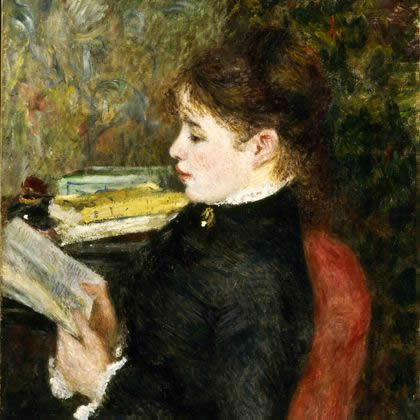
Double Take: From Monet to Lichtenstein is an intriguing exhibition culled from the private collection of Seattle businessman and philanthropist Paul G. Allen. There are 28 works on loan from the show, many of which have not been seen publicly for upwards of 50 years. The truly intriguing aspect of Double Take... is in its hanging, though. Exhibition curator Paul Hayes Tucker has creatively paired Impressionist and Post-Impressionist pieces with modern and contemporary works, placing the former side-by-side with the latter in groups of two or three. For art lovers - and anyone who has ever enjoyed the essay question that begins "Compare and contrast ..." - this show represents a rare treat.
"Double Take: From Monet to Lichtenstein" is on view from April 8 through September 24, 2006, at the Experience Music Project, 325 5th Ave. N., Seattle, WA 98109 (Telephone 206.367.5483 or 1.877.367.5483). "Double Take: From Monet to Lichtenstein" is a ticketed exhibition.
When Renoir painted La Liseuse he was about to participate in his final Impressionist exhibition, after which he would return to the official Salon and finally enjoy lasting financial success. By 1877, Renoir had nearly reached the place in his career where he could paint portraits wholly because he loved to do so, not merely because portraits are much easier to sell than landscapes. You see here the work of an artist who has hit his stride. There is nothing even remotely hesitant about his brushwork, and the composition is simple and confident - focusing, rightfully, on the reader's face in profile.
The sitter in this painting seems isolated by both her interior surroundings and the act of reading. We don't know what it is on those pages that have engaged her rapt attention. It seems quite clear, though, that we've stumbled across a scene that should not be disturbed, for she is obviously somewhere far away in her thoughts.
This painting is paired with Roy Lichtenstein's The Kiss (1962) in the exhibition Double Take: From Monet to Lichtenstein. Points to ponder: both canvases place great emphasis on color and surface texture, and neither woman is acknowledging our presence. In fact, both women seem quite oblivious to everything except that which might be happening in their respective minds.
About the Exhibition:
"Double Take: From Monet to Lichtenstein" is on view from April 8 through September 24, 2006, at the Experience Music Project, 325 5th Ave. N., Seattle, WA 98109 (on the Seattle Center Campus; Telephone 206.367.5483 or 1.877.367.5483). The EMP is open Monday through Thursday from 10:00 AM to 5:00 PM, and Friday through Sunday from 10:00 AM to 6:00 PM. Extended summer hours (effective Memorial Day weekend until Labor Day weekend) are 10:00 AM to 8:00 PM every day. "Double Take: From Monet to Lichtenstein" is a ticketed exhibition.
02
of 09
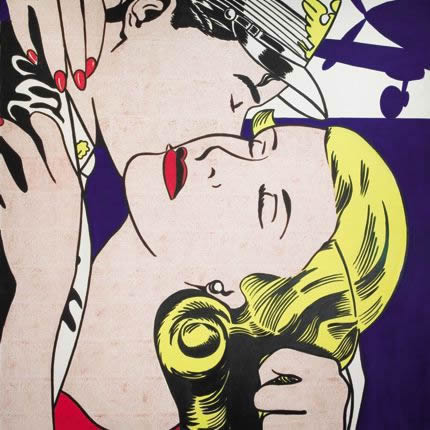
The Kiss was among the first "comic strip" paintings for which Roy Lichtenstein became instantly famous in art circles. He'd always been fascinated by the work of cartoonists and saw many parallels between their styles and those of modern "Fine Arts" masters. It was only when he plumbed the depths of comic-strips-as-art that he found his unique style. If it was delightfully ironic that Lichtenstein rose to prominence on the strength of replicating anonymous pulp techniques (such as half-tones, Ben-day dots and large blocks of the standard reds, yellows, blues and black used in inexpensive four-color printing), well, that just added to the humor factor, didn't it?
Here we have your basic blond vixen, complete with the expected red dress, nail polish, and lipstick, and she is doing ... something ... with her fly-boy suitor. Is he leaving? Did he just arrive? Is she happy or sad over the ramifications of either scenario? Most importantly, where is the kiss in The Kiss? We're seeing a little peck on the cheek when Blondie looks to be fully capable of a juicy lip-lock. Perhaps what's got her so preoccupied is fear of smearing her perfect lipstick -? Conflicting clues! Roy, you funny man, you - was this another of your sly jokes?
This painting is paired with Pierre-Auguste Renoir's La Liseuse (1877) in the exhibition Double Take: From Monet to Lichtenstein. Points to ponder: both canvases place great emphasis on color and surface texture, and neither woman is acknowledging our presence. In fact, both women seem quite oblivious to everything except that which might be happening in their respective minds.
About the Exhibition:
"Double Take: From Monet to Lichtenstein" is on view from April 8 through September 24, 2006, at the Experience Music Project, 325 5th Ave. N., Seattle, WA 98109 (on the Seattle Center Campus; Telephone 206.367.5483 or 1.877.367.5483). The EMP is open Monday through Thursday from 10:00 AM to 5:00 PM, and Friday through Sunday from 10:00 AM to 6:00 PM. Extended summer hours (effective Memorial Day weekend until Labor Day weekend) are 10:00 AM to 8:00 PM every day. "Double Take: From Monet to Lichtenstein" is a ticketed exhibition.
03
of 09

Maternité [II] was painted during Gauguin's self-imposed exile to Papeete during the years 1895-1901. He'd left France for the second and final time, and returned to Oceania vowing never to paint again " ...except as a distraction." Ironically, these years, optimistically dedicated to rest and restoration, saw Gauguin at the lowest points of his personal life: his beloved daughter died, his own health was poor, he had no money and, eventually, became so disheartened that he tried to commit suicide.
Gauguin seemed to experience rapid - if intermittent - bursts of creativity during this period. Maternité [II] was painted two years after his masterpiece Where do we come from? Who are we? Where are we going? (1897), and shares much of the latter's brilliant use of color, distorted figures and unrestrained execution. Two of the three women in Maternité [II] seem to stare at us dispassionately - perhaps reflecting Gauguin's ever-increasingly skeptical view of life.
This painting is paired with Kenji Yanobe's Atom Suit: Project: Desert 1 (1998) in the exhibition Double Take: From Monet to Lichtenstein. Points to ponder: both depict "otherworldly" figures placed without a fixed horizon, and we've been given no clear idea of that which either is meant to depict.
About the Exhibition:
"Double Take: From Monet to Lichtenstein" is on view from April 8 through September 24, 2006, at the Experience Music Project, 325 5th Ave. N., Seattle, WA 98109 (on the Seattle Center Campus; Telephone 206.367.5483 or 1.877.367.5483). The EMP is open Monday through Thursday from 10:00 AM to 5:00 PM, and Friday through Sunday from 10:00 AM to 6:00 PM. Extended summer hours (effective Memorial Day weekend until Labor Day weekend) are 10:00 AM to 8:00 PM every day. "Double Take: From Monet to Lichtenstein" is a ticketed exhibition.
04
of 09
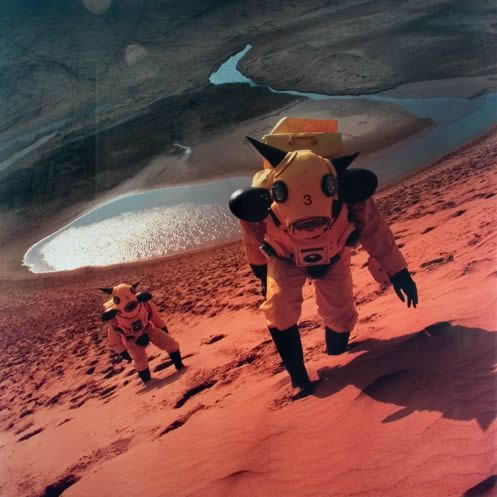
Frankly, I am most impressed that Mr. Allen thought to collect the work of Kenji Yanobe. He shows amazing foresight in doing so, for Yanobe's works are only going to increase in value in years to come. Lowbrow is definitely part of the collecting wave of the future, but Kenji Yanobe is some entirely different cutting edge to that movement.
Yanobe was born only two decades after his nation was twice devastated by atomic bombs and, as with much of Japanese anime and manga, post-apocalyptic themes play a major role in his work. Time and again one notices his use of constructions (often from "found" objects): giant - friendly - robots, anti-radiation suits for humans and dogs, Geiger counters and Godzilla suits designed for optimum crushing capabilities. The words are 3-D, sheltering, heroic and otaku. (This is the self-describing word utilized by Japanese fanboys and -girls obsessed with anime. If you cannot relate to anime, just think of the person you know who can relate every single baseball statistic from 1919 to the present. He'd be the baseball version of otaku.)
Here we see two of his fabricated "atomic space suits," replete with unexplained horns. The red tint may indicate the surface of Mars, or perhaps it's just a bit of fallout from the Chernobyl nuclear accident. Minus any other clues, only one thing is 100% evident. It's a long, hard slog up that sand dune - even without the additional weight of the suit.
This painting is paired with Paul Gauguin's Maternité [II] (1899) in the exhibition Double Take: From Monet to Lichtenstein. Points to ponder: both depict "otherworldly" figures placed without a fixed horizon, and we've no clear idea of that which either is meant to depict.
About the Exhibition:
"Double Take: From Monet to Lichtenstein" is on view from April 8 through September 24, 2006, at the Experience Music Project, 325 5th Ave. N., Seattle, WA 98109 (on the Seattle Center Campus; Telephone 206.367.5483 or 1.877.367.5483). The EMP is open Monday through Thursday from 10:00 AM to 5:00 PM, and Friday through Sunday from 10:00 AM to 6:00 PM. Extended summer hours (effective Memorial Day weekend until Labor Day weekend) are 10:00 AM to 8:00 PM every day. "Double Take: From Monet to Lichtenstein" is a ticketed exhibition.
05
of 09
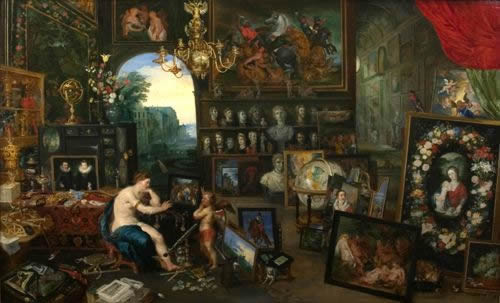
Jan Breughel II (a.k.a.: "the Younger") was a busy man in the mid-1620s. He'd been called back to Antwerp (after his father, Jan I, died of cholera) from a trip to Sicily with his old friend Anthony Van Dyck. Literally overnight, he found himself in charge of his father's studio and a slew of half-finished works. As if this weren't challenging enough, he also promptly married and began the work of siring eleven children.
Though he enjoyed moderate success because of his father's reputation, Jan the Younger was not in the same artistic league. Neither did he share Jan I's ability to create innovative themes. Throughout the latter 1620s, Jan II embarked on series after series of allegories: the Elements, the Seasons, "Abundance" and, of course, the Senses. Are you waiting for a happy ending? There wasn't one, at least not in his lifetime. Prices quickly hit a slippery downward slope from which they never recovered. The day when even one of his Five Senses would command a collector's ransom was centuries in the future.
Even so, here we have Sight separated from her four sisters. She is meant to be visually observing all of the many objects in the busy setting: statuary, Ruben-esque paintings, a globe, engravings, a resplendent chandelier, a small dog and Cupid (whom one could hardly ignore). For some unknown reason, the wearing of clothing would have interfered with this important sensual process.
This painting is hung with Georges Seurat's Les Poseuses (1888) and Pablo Picasso's Quatre Baigneuses (1921) in the exhibition Double Take: From Monet to Lichtenstein. Points to ponder: all three paintings have been executed with meticulous restraint and, quite obviously, contain central nude figures (though these are found in three very different settings, to three ends of various degrees of mystery).
About the Exhibition:
"Double Take: From Monet to Lichtenstein" is on view from April 8 through September 24, 2006, at the Experience Music Project, 325 5th Ave. N., Seattle, WA 98109 (on the Seattle Center Campus; Telephone 206.367.5483 or 1.877.367.5483). The EMP is open Monday through Thursday from 10:00 AM to 5:00 PM, and Friday through Sunday from 10:00 AM to 6:00 PM. Extended summer hours (effective Memorial Day weekend until Labor Day weekend) are 10:00 AM to 8:00 PM every day. "Double Take: From Monet to Lichtenstein" is a ticketed exhibition.
06
of 09
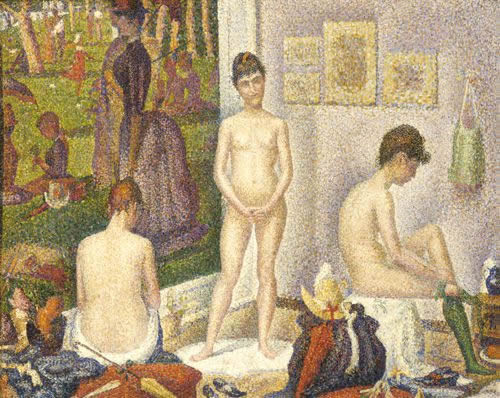
When one looks at the Pointillism that Seurat invented and marvels at the precision of thousands upon thousands of tiny dots of color -all created by one human hand! - it is mind-boggling to consider that he produced dozens of such labor-intensive canvases in the span of fewer than 10 years (and each only after many preliminary studies). Did he sleep, ever? Was he so obsessed with a technique that he became exhausted, and an early death was the only logical option left open to him?
The model here in Les Poseuses (if we are, indeed seeing one model in three poses, and not three women posing together) seems to be going through an after-bath sequence of drying herself and dressing. We've no idea, though, why she is doing so in front of a portion of Seurat's gigantic canvas A Sunday on La Grande Jatte -1884 (1884-86) - in which, it must be duly noted, all of the park-goers are respectably clothed.
This painting is hung with Jan Breughel the Younger's The Five Senses: Sight (1625) and Pablo Picasso's Quatre Baigneuses (1921) in the exhibition Double Take: From Monet to Lichtenstein. Points to ponder: all three paintings have been executed with meticulous restraint and, quite obviously, contain central nude figures (though these are found in three very different settings, to three ends of various degrees of mystery).
About the Exhibition:
"Double Take: From Monet to Lichtenstein" is on view from April 8 through September 24, 2006, at the Experience Music Project, 325 5th Ave. N., Seattle, WA 98109 (on the Seattle Center Campus; Telephone 206.367.5483 or 1.877.367.5483). The EMP is open Monday through Thursday from 10:00 AM to 5:00 PM, and Friday through Sunday from 10:00 AM to 6:00 PM. Extended summer hours (effective Memorial Day weekend until Labor Day weekend) are 10:00 AM to 8:00 PM every day. "Double Take: From Monet to Lichtenstein" is a ticketed exhibition.
07
of 09
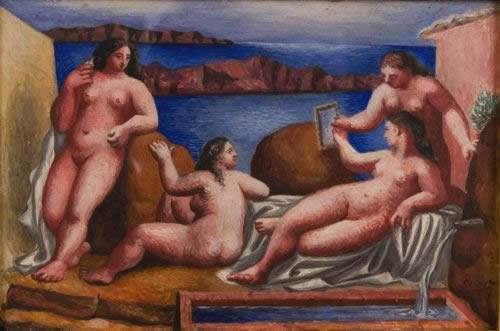
Honestly, it's never truly a party until Picasso shows up with a nude or two in tow.
Quatre Baigneuses, as seen here, is nearly its actual "postcard" size of 4 x 6 inches. At the time he painted this, Picasso was insanely busy going in many different directions at once. He was concurrently designing productions for the Ballets Russes, traveling widely, continuing to explore Cubism (as with his Three Musicians [1921]) and tentatively paying lightning visits to his Classical training (demonstrated above). "Classical," you say? My, yes. Picasso blew right through everything standard studio technique had to offer long before he was able to grow a proper beard. When he wanted to do so, the artist could trot out draftsmanship skills that would make a Renaissance master weep in envy. Picasso had to be that good, in order to ignore convention and follow other paths as successfully as he did.
Here he's gifted us with not one, not two, but four fleshy, rather Mediterranean lady bathers. It seems as if they have a narcissistic mirror to pass around, but there is nary a thong to be found amongst the quartet. Love Picasso or hate him, women of a Certain Age must appreciate - or, at least, acknowledge - that the artist had nothing against potbellies or large thighs.
This painting is hung with Jan Breughel the Younger's The Five Senses: Sight (1625) and Georges Seurat's Les Poseuses (1888) in the exhibition Double Take: From Monet to Lichtenstein. Points to ponder: all three paintings have been executed with meticulous restraint and, quite obviously, contain central nude figures (though these are found in three very different settings, to three ends of various degrees of mystery).
About the Exhibition:
"Double Take: From Monet to Lichtenstein" is on view from April 8 through September 24, 2006, at the Experience Music Project, 325 5th Ave. N., Seattle, WA 98109 (on the Seattle Center Campus; Telephone 206.367.5483 or 1.877.367.5483). The EMP is open Monday through Thursday from 10:00 AM to 5:00 PM, and Friday through Sunday from 10:00 AM to 6:00 PM. Extended summer hours (effective Memorial Day weekend until Labor Day weekend) are 10:00 AM to 8:00 PM every day. "Double Take: From Monet to Lichtenstein" is a ticketed exhibition.
08
of 09
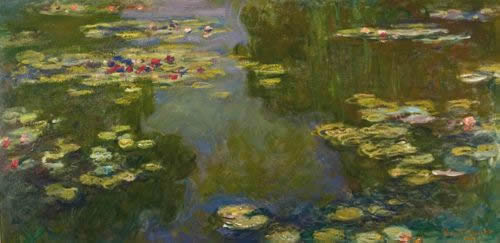
More than any other artist in the Impressionist circle, Claude Monet never tired of exploring the movement down to its most basic elements. He'd methodically - albeit rapidly - paint the exact same scene over and over, the only variables being the angles of light, time of day and weather conditions. It is a testament to his patience and artistic mastery that these same scenes all came out distinctly different from one another.
Here we see one of the numerous, large "waterlilies" for which Monet is so well-known today. He'd enlarged his pond in the gardens at Giverny for the final time in 1910 but was plagued afterward with depression over the death of his beloved wife, Alice (in 1914), increasingly problematic cataracts and the considerable distractions of WWI. By the time 1919 rolled around, he was bravely attempting to soldier on in an expanded studio, the walls of which were covered for 360-degrees with massive canvases meant for pictures of his pond. Le Bassin au Nympheas is one result of his determination to continue painting - regardless - until he drew his last breath. We are so fortunate that he made the effort.
This painting is paired with Willem de Kooning's Untitled XII (1975) in the exhibition Double Take: From Monet to Lichtenstein. Points to ponder: both paintings are large in scale (yet organized around a center), make full use of the available canvas and were executed in such a way that texture and perceived depth play prominent roles.
About the Exhibition:
"Double Take: From Monet to Lichtenstein" is on view from April 8 through September 24, 2006, at the Experience Music Project, 325 5th Ave. N., Seattle, WA 98109 (on the Seattle Center Campus; Telephone 206.367.5483 or 1.877.367.5483). The EMP is open Monday through Thursday from 10:00 AM to 5:00 PM, and Friday through Sunday from 10:00 AM to 6:00 PM. Extended summer hours (effective Memorial Day weekend until Labor Day weekend) are 10:00 AM to 8:00 PM every day. "Double Take: From Monet to Lichtenstein" is a ticketed exhibition.
09
of 09
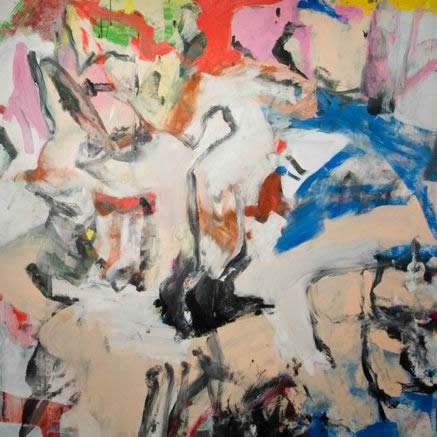
Along with Jackson Pollock and Mark Rothko, Willem de Kooning was a member of the New York School "triumvirate" of Post-war Abstract Expressionism. What was unique - and rather notorious - about de Kooning's paintings were the obvious figurative (note the flesh tones) elements in his abstractions.
Here we have Untitled XII in the grand tradition of de Kooning's several Women series, first executed in the late 1940s. By the mid-1970s, he'd softened his approach somewhat, and the temptation for the viewer to pick out horrific dismemberments of limbs and sinister grins had largely disappeared. The "fear factor" being lessened, de Kooning seemed freer to concentrate on strategically placing his shapes and bursts of color within his compositions.
This painting is paired with Claude Monet's Le Bassin au Nympheas (1919) in the exhibition Double Take: From Monet to Lichtenstein. Points to ponder: both paintings are large in scale (yet organized around a center), make full use of the available canvas and were executed in such a way that texture and perceived depth play prominent roles.
About the Exhibition:
"Double Take: From Monet to Lichtenstein" is on view from April 8 through September 24, 2006, at the Experience Music Project, 325 5th Ave. N., Seattle, WA 98109 (on the Seattle Center Campus; Telephone 206.367.5483 or 1.877.367.5483). The EMP is open Monday through Thursday from 10:00 AM to 5:00 PM, and Friday through Sunday from 10:00 AM to 6:00 PM. Extended summer hours (effective Memorial Day weekend until Labor Day weekend) are 10:00 AM to 8:00 PM every day. "Double Take: From Monet to Lichtenstein" is a ticketed exhibition.
